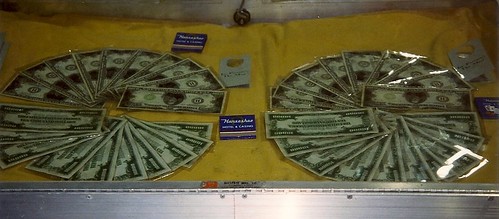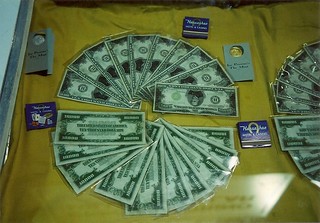
PREV ARTICLE
NEXT ARTICLE
FULL ISSUE
PREV FULL ISSUE
NOTES FROM E-SYLUM READERS: FEBRUARY 22, 2015The Society of Medalist Medals The Society of Medalist medals, 1930 onward, are one of the greatest “hidden secrets” in numismatics. Sculptors, medalists, and others were given free will to create medals of their own design (not influenced by commerce or patrons, as usual). Offered for sale by Joe Levine (recently in the list you mention) and frequently on eBay, and often for less than $100 each, these are worth adding to any collection. Dave Alexander’s book on the subject, published by ANS (with my encouragement), tells all. To read the earlier E-Sylum article, see: Coin & Currency Institute Distributing Hungarian Wooden Medals I just learned that distributor Coin & Currency Institute will offer the medals and keychains to North American buyers, for $9.95 and $12.50, respectively. To order, visit its website, www.coin-currency.com. To read the earlier E-Sylum article, see: Shipping Books from Germany On my last trip I had put 4 copies of my recent book in sealed mailing envelopes to be sent from Berlin to people (in Germany and Switzerland) I owed copies to. It was cheaper to mail from Germany to other parts of the world (7 euros, or about $9.50 per book) compared to $24-$25 the United States Postal Service charges (per book!). And this is without insurance or tracking. Then the TSA tore open every mailing envelope, I guess to see what was inside. Well, I learned a lesson for the several books this time I had to mail to Greece, India and the UK – I left the books unpacked and pre-addressed the mailers, leaving them unsealed and separate from the books. The books arrived unharmed this time. Two of the books were sent (from London) to other parts of the UK, costing only £3.20 ($4.94) each. The only downside was that until I actually could mail the books, I had to schlep them around. At almost 1.9 pounds each, the 5 books added an extra 9.5 pounds (20.5 kg) when I left home. You should note that from this experience, if you plan to carry any presents/gifts on any flight starting from the US, either to another US city or overseas, DON’T WRAP IT. Just leave it naked in the original box. Although neither of us would recommend flying to Europe just mail things cheaper, it is an interesting option for frequent travelers
like Howard. -Editor
Determining the Highest Value Banknote I see nobody understood David Pickup's question properly. He wanted to know what is the world's highest priced currency in unit terms. Thus, for example, the one US dollar (USD) is 0.87822 Euros (EUR) and just 0.6503 British pounds (GBP) as of this writing. The most "valuable" currency I found was the terms of units per US Dollar was the Seborgan Luigino (SPL) at 0.16666 (or 6 dollars per Luigino) followed by the Kuwaiti Dinar (KWD) at 0.29618 units per USD, or 3.37637 USD per Dinar. The best source for this information is XE's currency converter table, to be found here: http://www.xe.com/currencytables/# To use XE Currency Tables, just follow these simple instructions: Well, this gets us closer, but we still need to map currency units to actual banknotes, by multiplying the value of the base unit by
the denomination. If the Northumbrian Bango is worth 5 cents but their largest banknote is 2,500 Bangos, then the value of that note is more than the
largest U.S. banknote, the $100 bill. I was hoping some economic publication might have a table laying that out for us. -Editor
Alan adds: I believe the largest US banknote is $100,000, not $100. In any case, the $5,000 and $10,000 notes are larger too. True. I think I would qualify the question to eliminate non-circulating notes like those and the British 100M pound note, but point
taken. Speaking of large-denomination notes, see the next item from Phil Iverson. -Editor
To read the earlier E-Sylum article, see: Binion’s Horseshoe Casino $10,000 Notes Sometime last year there were some articles about the million dollar exhibit in Las Vegas at Binion’s Horseshoe Casino. While going through a box of photos I found a couple of photographs of some of the $10,000 notes I took at the February 2000 Long Beach Expo. that a dealer had.  Thanks! -Editor
To read the earlier E-Sylum article, see: Wayne Homren, Editor The Numismatic Bibliomania Society is a non-profit organization promoting numismatic literature. See our web site at coinbooks.org. To submit items for publication in The E-Sylum, write to the Editor at this address: whomren@gmail.com To subscribe go to: https://my.binhost.com/lists/listinfo/esylum All Rights Reserved. NBS Home Page Contact the NBS webmaster 
|

